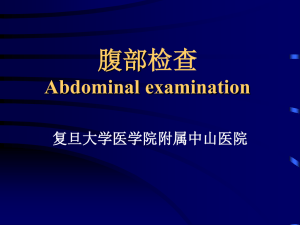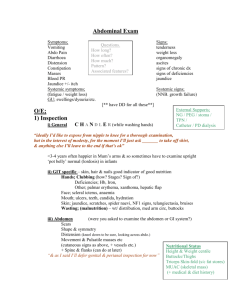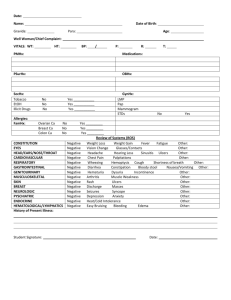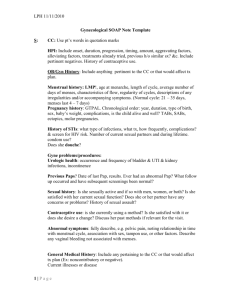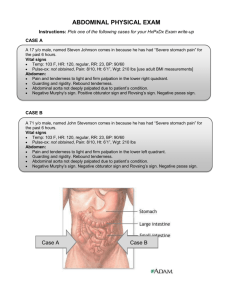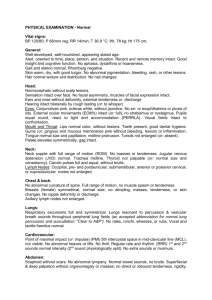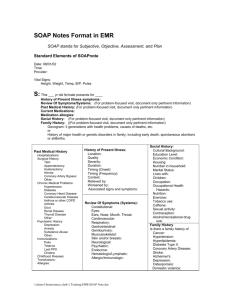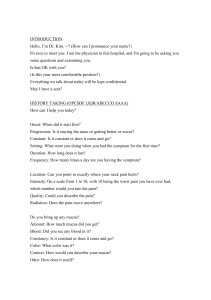General Multi-System Exam
advertisement
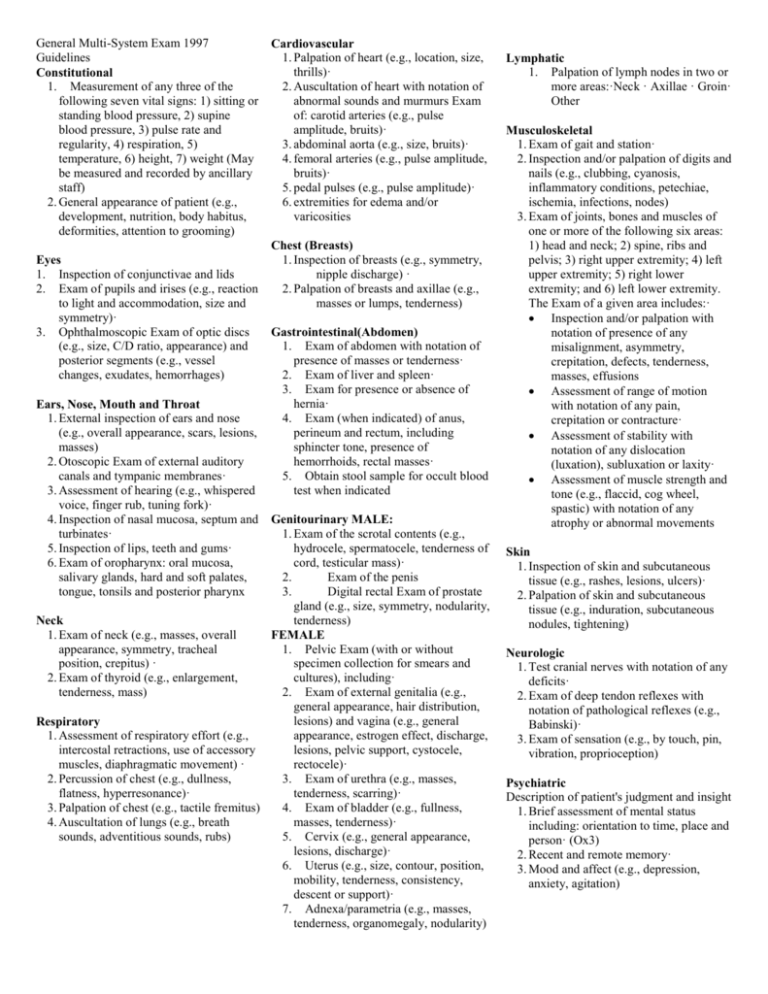
General Multi-System Exam 1997 Guidelines Constitutional 1. Measurement of any three of the following seven vital signs: 1) sitting or standing blood pressure, 2) supine blood pressure, 3) pulse rate and regularity, 4) respiration, 5) temperature, 6) height, 7) weight (May be measured and recorded by ancillary staff) 2. General appearance of patient (e.g., development, nutrition, body habitus, deformities, attention to grooming) Eyes 1. Inspection of conjunctivae and lids 2. Exam of pupils and irises (e.g., reaction to light and accommodation, size and symmetry)· 3. Ophthalmoscopic Exam of optic discs (e.g., size, C/D ratio, appearance) and posterior segments (e.g., vessel changes, exudates, hemorrhages) Ears, Nose, Mouth and Throat 1. External inspection of ears and nose (e.g., overall appearance, scars, lesions, masses) 2. Otoscopic Exam of external auditory canals and tympanic membranes· 3. Assessment of hearing (e.g., whispered voice, finger rub, tuning fork)· 4. Inspection of nasal mucosa, septum and turbinates· 5. Inspection of lips, teeth and gums· 6. Exam of oropharynx: oral mucosa, salivary glands, hard and soft palates, tongue, tonsils and posterior pharynx Cardiovascular 1. Palpation of heart (e.g., location, size, thrills)· 2. Auscultation of heart with notation of abnormal sounds and murmurs Exam of: carotid arteries (e.g., pulse amplitude, bruits)· 3. abdominal aorta (e.g., size, bruits)· 4. femoral arteries (e.g., pulse amplitude, bruits)· 5. pedal pulses (e.g., pulse amplitude)· 6. extremities for edema and/or varicosities Chest (Breasts) 1. Inspection of breasts (e.g., symmetry, nipple discharge) · 2. Palpation of breasts and axillae (e.g., masses or lumps, tenderness) Gastrointestinal(Abdomen) 1. Exam of abdomen with notation of presence of masses or tenderness· 2. Exam of liver and spleen· 3. Exam for presence or absence of hernia· 4. Exam (when indicated) of anus, perineum and rectum, including sphincter tone, presence of hemorrhoids, rectal masses· 5. Obtain stool sample for occult blood test when indicated Genitourinary MALE: 1. Exam of the scrotal contents (e.g., hydrocele, spermatocele, tenderness of cord, testicular mass)· 2. Exam of the penis 3. Digital rectal Exam of prostate gland (e.g., size, symmetry, nodularity, tenderness) Neck 1. Exam of neck (e.g., masses, overall FEMALE appearance, symmetry, tracheal 1. Pelvic Exam (with or without position, crepitus) · specimen collection for smears and 2. Exam of thyroid (e.g., enlargement, cultures), including· tenderness, mass) 2. Exam of external genitalia (e.g., general appearance, hair distribution, lesions) and vagina (e.g., general Respiratory 1. Assessment of respiratory effort (e.g., appearance, estrogen effect, discharge, intercostal retractions, use of accessory lesions, pelvic support, cystocele, muscles, diaphragmatic movement) · rectocele)· 2. Percussion of chest (e.g., dullness, 3. Exam of urethra (e.g., masses, flatness, hyperresonance)· tenderness, scarring)· 3. Palpation of chest (e.g., tactile fremitus) 4. Exam of bladder (e.g., fullness, 4. Auscultation of lungs (e.g., breath masses, tenderness)· sounds, adventitious sounds, rubs) 5. Cervix (e.g., general appearance, lesions, discharge)· 6. Uterus (e.g., size, contour, position, mobility, tenderness, consistency, descent or support)· 7. Adnexa/parametria (e.g., masses, tenderness, organomegaly, nodularity) Lymphatic 1. Palpation of lymph nodes in two or more areas:·Neck · Axillae · Groin· Other Musculoskeletal 1. Exam of gait and station· 2. Inspection and/or palpation of digits and nails (e.g., clubbing, cyanosis, inflammatory conditions, petechiae, ischemia, infections, nodes) 3. Exam of joints, bones and muscles of one or more of the following six areas: 1) head and neck; 2) spine, ribs and pelvis; 3) right upper extremity; 4) left upper extremity; 5) right lower extremity; and 6) left lower extremity. The Exam of a given area includes:· Inspection and/or palpation with notation of presence of any misalignment, asymmetry, crepitation, defects, tenderness, masses, effusions Assessment of range of motion with notation of any pain, crepitation or contracture· Assessment of stability with notation of any dislocation (luxation), subluxation or laxity· Assessment of muscle strength and tone (e.g., flaccid, cog wheel, spastic) with notation of any atrophy or abnormal movements Skin 1. Inspection of skin and subcutaneous tissue (e.g., rashes, lesions, ulcers)· 2. Palpation of skin and subcutaneous tissue (e.g., induration, subcutaneous nodules, tightening) Neurologic 1. Test cranial nerves with notation of any deficits· 2. Exam of deep tendon reflexes with notation of pathological reflexes (e.g., Babinski)· 3. Exam of sensation (e.g., by touch, pin, vibration, proprioception) Psychiatric Description of patient's judgment and insight 1. Brief assessment of mental status including: orientation to time, place and person· (Ox3) 2. Recent and remote memory· 3. Mood and affect (e.g., depression, anxiety, agitation)
